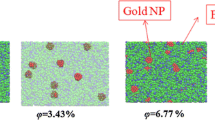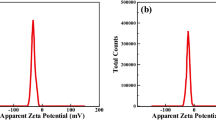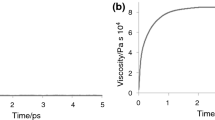Abstract
The physical behavior of a nanofluids is still not fully understood. This work focuses on the study and understanding of equilibrium thermodynamic properties of several gold–water nanofluids using molecular dynamics simulations. Three different systems are considered, where gold nanoparticles with diameters of 2.6, 5.8, and 6.6 nm are suspended in water for effective nanoparticle volume fractions of 1, 10, and 15 %, respectively. Novelties of this study are in the use of accurate force fields for modeling the inter- and intramolecular interactions of the components, and providing comprehensive thermodynamic properties of the nanofluids. The results are validated with the pure fluid and solid properties. Results indicate that the thermodynamics of the system does not behave as an ideal mixture, due to a combination of several factors such as liquid layering, anisotropicity, and other solid–liquid interfacial effects.









Similar content being viewed by others
References
Alejandre J, Tildesley DJ, Chapela GA (1995) Molecular dynamics simulation of the orthobaric densities and surface tension of water. J Chem Phys 102(11):4574–4583
Allen MP, Tildesley DJ (1997) Computer simulation of liquids. Oxford University Press, Oxford
Berendsen HJC, Postma JPM, van Gunsteren WF, Hermans J (1981) Intermolecular forces. Reidel, Dordrecht
Berendsen HJC, Grigera JR, Straatsma TP (1987) The missing term in effective pair potentials. J Phys Chem 91(24):6269–6271
Berens PH, Mackay DHJ, White GM, Wilson KR (1983) Thermodynamics and quantum corrections from molecular dynamics for liquid water. J Chem Phys 79(5):2375–2389
Bergman T (2009) Effect of reduced specific heats of nanofluids on single phase, laminar internal forced convection. Int J Heat Mass Transf 52(5-6):1240–1244
Bilic A, Reimers JR, Hush NS, Hafner J (2002) Adsorption of ammonia on the gold (111) surface. J Phys Chem 116(20):8981–8987
Buongiorno J (2006) Convective transport in nanofluids. J Heat Transf 128(3):240–250
Buongiorno J, Hu L (2009) Innovative technologies: two-phase heat transfer in water-based nanofluids for nuclear applications, final report. Tech. rep., Massachusetts Institute of Technology
Buongiorno J, Venerus DC, Prabhat N, McKrell T, Townsend J, Christianson R, Tolmachev YV, Keblinski P, Hu LW, Alvarado JL, Bang IC, Bishnoi SW, Bonetti M, Botz F, Cecere A, Chang Y, Chen G, Chen H, Chung SJ, Chyu MK, Das SK, Di Paola R, Ding Y, Dubois F, Dzido G, Eapen J, Escher W, Funfschilling D, Galand Q, Gao J, Gharagozloo PE, Goodson KE, Gutierrez JG, Hong H, Horton M, Hwang KS, Iorio CS, Jang SP, Jarzebski AB, Jiang Y, Jin L, Kabelac S, Kamath A, Kedzierski MA, Kieng LG, Kim C, Kim JH, Kim S, Lee SH, Leong KC, Manna I, Michel B, Ni R, Patel H, Philip J, Poulikakos D, Reynaud C, Savino R, Singh PK, Song P, Sundararajan T, Timofeeva E, Tritcak T, Turanov AN, Van Vaerenbergh S, Wen D, Witharana S, Yang C, Yeh WH, Zhao XZ, Zhou SQ (2009) A benchmark study on the thermal conductivity of nanofluids. J Appl Phys 106(9):094312
Callen HB (1985) Thermodynamics and an introduction to thermostatistics, 2nd edn. Wiley, New York
Çağin T, Dereli G, Uludoğan M, Tomak M (1999) Thermal and mechanical properties of some fcc transition metals. Phys Rev B 59(5):3468–3473
Chang CI, Lee WJ, Young TF, Ju SP, Chang CW, Chen HL, Chang JG (2008) Adsorption mechanism of water molecules surrounding Au nanoparticles of different sizes. J Chem Phys 128(15):154,703
Corcione M (2011) Rayleigh–Bénard convection heat transfer in nanoparticle suspensions. Int J Heat Fluid Flow 32(1):65–77
Das SK, Choi SUS, Yu W, Pradeep T (2007) Nanofluids: science and technology. Wiley, Hoboken
Daw MS, Baskes MI (1984) Embedded-atom method: derivation and application to impurities, surfaces, and other defects in metals. Phys Rev B 29(12):6443–6453
Dou Y, Zhigilei LV, Winograd N, Garrison BJ (2001) Explosive boiling of water films adjacent to heated surfaces: a microscopic description. J Phys Chem A 105(12):2748–2755
Dullweber A, Leimkuhler B, McLachlan R (1997) Symplectic splitting methods for rigid body molecular dynamics. J Chem Phys 107(15):5840–5851
Eisenberg D, Kauzmann W (1969) The structure and properties of water. Oxford University Press, New York
Escher W, Brunschwiler T, Shalkevich N, Shalkevich A, Bürgi T, Michel B, Poulikakos D (2011) On the cooling of electronics with nanofluids. J Heat Transf 133(5):051,401
Firoozabadi A, Nutakki R, Wong TW, Aziz K (1988) EOS predictions of compressibility and phase behavior in systems containing water, hydrocarbons, and CO2. SPE Reserv Eng 3(2):673–684
Fox GC, Johnson MA, Lyzenga GA, Otto SW, Salmon JK, Walker DW (1988) Solving problems on concurrent processors, vol 1. Prentice-Hall, Englewood Cliffs
Frenkel D, Smit B (2001) Understanding molecular simulation: from algorithms to applications, 2nd edn. Academic Press, San Diego
Godson L, Raja B, Mohan Lal D, Wongwises S (2010) Enhancement of heat transfer using nanofluids—an overview. Ren Sust En Rev 14(2):629–641
Haile JM (1997) Molecular dynamics simulation: elementary methods. Wiley, New York
Hendrickson B, Plimpton S (1995) Parallel many-body simulations without all-to-all communication. J Par Dist Comput 27(1):15–25
Hoover WG (1984) Canonical dynamics: equilibrium phase-space distributions. Phys Rev A 31(3):1695–1697
Jiang W, Ding G, Peng H (2009) Measurement and model on thermal conductivities of carbon nanotube nanorefrigerants. Int J Therm Sci 48(6):1108–1115
Ju SP, Chang JG, Lin JS, Lin YS (2005) The effects of confinement on the behavior of water molecules between parallel Au plates of (001) planes. J Chem Phys 122(15):154,707
Keblinski P, Prasher R, Eapen J (2008) Thermal conductance of nanofluids: is the controversy over. J Nanopart Res 10(7):1089–1097
Kenyon DE (1976) The theory of an incompressible solid–fluid mixture. Arch Ration Mech Anal 62(2):131–147
Kimura Y, Qi Y, Cagin T, Goddard WA (1998) The quantum Sutton–Chen many-body potential for properties of fcc metals. Caltech ASCI Technical Report. California Institute of Technology, Pasadena, California, USA
Kole M, Dey TK (2011) Effect of aggregation on the viscosity of copper oxide–gear oil nanofluids. Int J Therm Sci 50(9):1741–1747
Kusalik PG, Svishchev IM (1994) The spatial structure in liquid water. Sci Agric 265(5176):1219–1221
Leach AR (2001) Molecular modelling: principles and applications, 2nd edn. Prentice Hall, Essex
Lee J, Mudawar I (2007) Assessment of the effectiveness of nanofluids for single-phase and two-phase heat transfer in micro-channels. Int J Heat Mass Transf 50(3–4):452–463
Lee JK, Koo J, Hong H, Kang YT (2010) The effects of nanoparticles on absorption heat and mass transfer performance in NH3/H2O binary nanofluids. Int J Refrig 33(2):269–275
Leong KY, Saidur R, Kazi SN, Mamun AH (2010) Performance investigation of an automotive car radiator operated with nanofluid-based coolants (nanofluid as a coolant in a radiator). Appl Therm Eng 30(17-18):2685–2692
Levitt M, Hirshberg M, Sharon R, Laidig KE, Daggett V (1997) Calibration and testing of a water model for simulation of the molecular dynamics of proteins and nucleic acids in solution. J Phys Chem B 101(25):5051–5061
Li XF, Zhu DS, Wang XJ, Wang N, Gao JW, Li H (2008) Thermal conductivity enhancement dependent pH and chemical surfactant for Cu–H2O nanofluids. Thermochim Acta 469(1–2):98–103
Lide DR (2006) CRC handbook of chemistry and physics, 87th edn. CRC Press, Cleveland
McQuarrie DA (2000) Statistical mechanics. University Science Books, Sausalito
Meineke MA, Vardeman CF, Lin T, Fennell CJ, Gezelter JD (2005) OOPSE: an object-oriented parallel simulation engine for molecular dynamics. J Comput Chem 26(3):252–271
Melchionna S, Ciccotti G, Holian BL (1993) Hoover NPT dynamics for systems varying in shape and size. Mol Phys 78(3):533–544
Namburu PK, Das DK, Tanguturi KM, Vajjha RS (2009) Numerical study of turbulent flow and heat transfer characteristics of nanofluids considering variable properties. Int J Therm Sci 48(2):290–302
Nelson IC, Banerjee D, Ponnappan R (2009) Flow loop experiments using polyalphaolefin nanofluids. J Thermophys Heat Transf 23(4):752–761
Pak BC, Cho YI (1998) Hydrodynamic and heat transfer study of dispersed fluids with submicron metallic oxide particles. Exp Heat Transf 11(2):151–170
Patel H, Das SK, Sundararajan T, Sreekumaran NA, George B, Pradeep T (2003) Thermal conductivities of naked and monolayer protected metal nanoparticle based nanofluids: manifestation of anomalous enhancement and chemical effects. Appl Phys Lett 83(14):2931–2933
Peyghambarzadeh SM, Hashemabadi SH, Jamnani MS, Hoseini SM (2011) Improving the cooling performance of automobile radiator with Al2O3/water nanofluid. Appl Therm Eng 31(10):1833–1838
Plimpton S (1995) Fast parallel algorithms for short-range molecular-dynamics. J Comput Phys 117(1):1–19
Plimpton S, Hendrickson BA (1993) Parallel molecular dynamics with the embedded atom method. In: Broughton J, Bristowe P, Newsam J (eds) Materials Theory and Modelling, vol 291. MRS Proceedings, Pittsburgh, p 37
Postma JPM (1985) A molecular dynamic study of water. PhD thesis, University of Groningen, The Netherlands
Puliti G, Paolucci S, Sen M (2011) Thermodynamic properties of gold–water nanolayer mixtures using molecular dynamics. J Nanopart Res 13(9):4277–4293
Puliti G, Paolucci S, Sen M (2012) Nanofluids and their properties. Appl Mech Rev 65(2):021,001
Qi Y, Çağin T, Kimura Y, Goddard WA (1999) Molecular-dynamics simulations of glass formation and crystallization in binary liquid metals: Cu–Ag and Cu–Ni. Phys Rev B 59(5):3527–3533
Saidur R, Kazi SN, Hossain MS, Rahman MM, Mohammed HA (2011) A review on the performance of nanoparticles suspended with refrigerants and lubricating oils in refrigeration systems. Ren Sust En Rev 15(1):310–323
Saidur R, Leong KY, Mohammad HA (2011) A review on applications and challenges of nanofluids. Ren Sust En Rev 15(3):1646–1668
Sergis A, Hardalupas Y (2011) Anomalous heat transfer modes of nanofluids: a review based on statistical analysis. Nanoscale Res Lett 6(1):391
Shin D, Banerjee D (2011) Enhancement of specific heat capacity of high-temperature silica-nanofluids synthesized in alkali chloride salt eutectics for solar thermal-energy storage applications. Int J Heat Mass Transf 54(5-6):1064–1070
Spohr E (1989) Computer simulation of the water/platinum interface. J Phys Chem 93(16):6171–6180
Sridhara V, Gowrishankar BS, Snehalatha C, Satapathy LN (2009) Nanofluids—a new promising fluid for cooling. Trans Indian Ceramic Soc 68(1):1–17
Vajjha RS, Das DK (2009) Specific heat measurement of three nanofluids and development of new correlations. J Heat Transf 131(7):071,601
Waheed Q, Edholm O (2011) Quantum corrections to classical molecular dynamics simulations of water and ice. J Chem Theory Comput 7(9):2903–2909
Wang XQ, Mujumdar AS (2008) A review of nanofluids—Part I: theoretical and numerical investigations. Braz J Chem Eng 25(4):613–630
Wang XQ, Mujumdar AS (2008) A review on nanofluids—Part II: experiments and applications. Braz J Chem Eng 25(4):631–648
Wang Z (2009) Thermal wave in thermal properties measurements and flow diagnostics: with applications of nanofluids thermal conductivity and wall shear stress measurements. PhD thesis, Oregon State University, Corvallis, OR
Wedberg R, Peters GH, Abildskov J (2008) Total correlation function integrals and isothermal compressibilities from molecular simulations. Fluid Phase Equilib 273(1–2):1–10
Wu Y, Lin J, Ju S, Lee W, Lin Y, Hwang C (2007) The behavior of water molecules nanoconfined between parallel Au plates. Comput Mater Sci 39(2):359–364
Xuan YM, Li Q (2000) Heat transfer enhancement of nanofluids. Int J Heat Fluid Flow 21(1):58–64
Xuan YM, Li Q, Hu WF (2003) Aggregation structure and thermal conductivity of nanofluids. AIChE J 49(4):1038–1043
Yang AC, Weng CI, Chen TC (2011) Behavior of water molecules near monolayer-protected clusters with different terminal segments of ligand. J Chem Phys 135(3):034,101
Yu W, France DM, Choi SUS, Routbort JL (2007) Review and assessment of nanofluid technology for transportation and other applications. Tech. rep., Energy Systems Division, Argonne National Laboratory
Zhou SQ, Ni R (2008) Measurement of the specific heat capacity of water-based Al2O3 nanofluid. Appl Phys Lett 92(9):093,123
Acknowledgments
This work was funded by the United States Department of Energy, grant number DE-FG02-05CH11294. This research used resources of the National Energy Research Scientific Computing Center, which is supported by the Office of Science of the U.S. Department of Energy under Contract No. DE-AC02-05CH11231. We also acknowledge the Center for Research Computing at the University of Notre Dame. Special thanks are also due to Drs. Daniel Gezelter and Charles Vardeman II for their support with the molecular dynamics package OpenMD.
Author information
Authors and Affiliations
Corresponding author
Rights and permissions
About this article
Cite this article
Puliti, G., Paolucci, S. & Sen, M. Thermodynamic properties of gold–water nanofluids using molecular dynamics. J Nanopart Res 14, 1296 (2012). https://doi.org/10.1007/s11051-012-1296-4
Received:
Accepted:
Published:
DOI: https://doi.org/10.1007/s11051-012-1296-4




